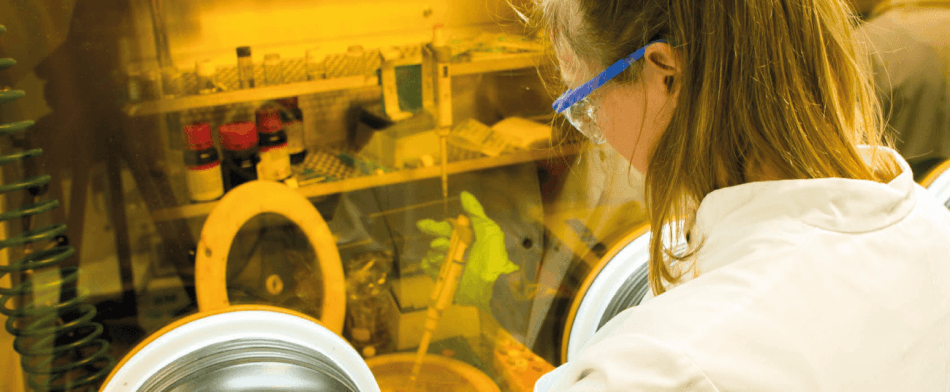Apr 8 2019
Perovskite solar cells are a sensation among other fellow photovoltaic materials: When used as a layer covering a silicon solar cell, they can the efficiency of the cell by more than 30%.
 In the lab at the Helmholtz-Zentrum, Berlin. (Image credit: European Science Communication Institute)
In the lab at the Helmholtz-Zentrum, Berlin. (Image credit: European Science Communication Institute)
In addition, such solar cells are inexpensive and can be easily produced. Due to this, they are the fastest developing solar technology so far. Researchers of the EU-funded research project GRECO are presently trying a new method to produce perovskite-silicon tandems.
The work on perovskites is headed by Dr Elisa Antolín from the Silicon and New Concepts for Solar Cells Group at the Instituto de Energía Solar, Universidad Politécnica de Madrid (UPM). Dr Antolín and her group are part of the research project GRECO, which intends, apart from other things, to develop six cutting-edge photovoltaic products.
One of our main goals within GRECO is to significantly increase the efficiency of solar cells. So we are looking for a truly innovative concept.
Dr Elisa Antolín, Silicon and New Concepts for Solar Cells, Instituto de Energía Solar, Universidad Politécnica de Madrid
At present, two-terminal and four-terminal silicon-perovskite tandems are being created across the world. However, GRECO-researchers are seeking further prospects.
GRECO is led by Dr Ana Belén Cristóbal López and Prof. Carlos del Cañizo Nadal from the same institute at UPM. GRECO began in June 2018 and will function until May 2021. It is dependent on three pillars: Citizen Science, Open Science, and Innovative Research. GRECO is leading the core ecological, political, and societal needs both within the EU and across the world.
GRECO will set an example on how to implement Open Science in photovoltaics and how to transfer this knowledge to other research fields.
Dr Ana Belén Cristóbal López, Instituto de Energía Solar, Universidad Politécnica de Madrid
Moreover, GRECO is rightly in accordance with the EU Strategic Energy Technology Plan (SET). The SET plan encourages research and innovation across Europe by backing the most effective technology toward a change to a low-carbon energy system. On an international level, GRECO also contributes to the action plan of the 2015 Paris Agreement, the target of which is to minimize emissions to decrease global warming to 1.5 °C.
Furthermore, very significantly, the outcomes of the EU Special Eurobarometer 435 of November 2015 show that nearly half of all Europeans assume that climate change is one of the world’s most critical issues. Hence, it is necessary for the GRECO investigators to come up with an idea for high-efficiency solar cells.
Dr Elisa Antolín works in close collaboration with Dr Eva Unger at the Helmholtz Zentrum in Berlin. Dr Unger leads the Young Investigator Group Hybrid Materials Formation and Scaling. In addition, they are part of GRECO and specialists in perovskite solar cells. Elisa Antolín and Eva Unger are now bringing an excellent concept to life: They will create a prototype of a three-terminal perovskite-silicon tandem.
This is an entirely new approach because we are not aiming for two-terminal or four-terminal tandems. These are already well established with performance beyond 27 percent. The three-terminal tandem may boost the performance of conventional silicon devices potentially beyond 30 percent!
Dr Eva Unger, Helmholtz Zentrum, Berlin
Normally, tandem solar cells are more efficient since the different materials, such as silicon and perovskites, absorb complementary fractions of sunlight. Hence, they produce more electricity when compared to the plain silicon ones and can be used as an “add-on” layer above the existing silicon cells. To correspond with the existing silicon solar cell technology, perovskite solar cells must endure up to 25 years. However, the three-terminal concept is groundbreaking, but difficult to execute.
Simply put, the working of a solar cell is similar to that of a battery: there is a constant negative and positive contact. The electrons inside the cell are obtained at the negative pole and returned to the positive one. The potential between them generates electricity.
In a two-terminal tandem, two cells with the identical electrical charge are piled up “plus to minus.” In a four-terminal tandem, the power from the individual solar cell is obtained separately. The advantage is higher efficiency.
In a three-terminal cell, the two solar cells are coupled “minus-to-minus” or “plus-to-plus.” In a two-terminal tandem, the device producing the lower current will limit the overall performance of the tandem device. Three-terminal devices do not have this limitation, which implies even higher efficiency.
However, the three-terminal cell necessitates the design of a highly conductive and also very transparent intermediate contact layer where current can be obtained efficiently.
Besides, there is another issue: How will it be possible to efficiently increase the production of the perovskite-silicon tandems? The solution is advanced, but easy: A unique printer can do the magic.
With an ink-jet printer, which is similar to the ones you might know from your home office, we are printing the material also to larger areas to make it compatible with square metres of silicon solar cell technology.
Dr Eva Unger, Helmholtz Zentrum, Berlin
Towards the end of May 2021, the GRECO scientists will reveal the outcomes of their study on three-terminal perovskite-silicon tandems and thereby contribute to solving a technical as well as a worldwide issue.